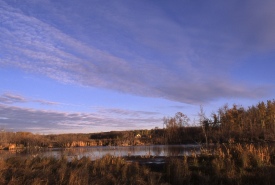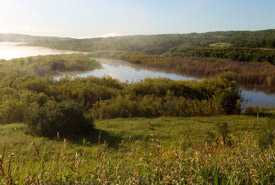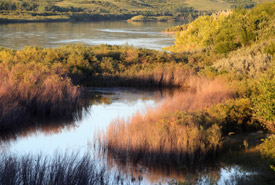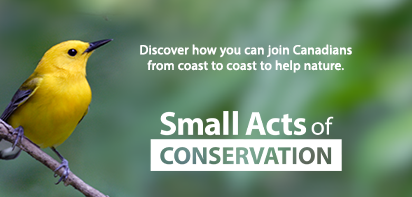Aspen parkland forest

Aspen Parkland in the fall, Saskatchewan (Photo by Don and Karol Dabbs)
The aspen parkland is a unique landscape with a rich history.
In the late 1850s, John Palliser led a survey expedition to western Canada to explore routes for the Canadian Pacific Railway. He named the driest part of the Prairies the Palliser Triangle. In his report, Palliser described it as "desert, or semi-desert in character, which can never be expected to become occupied by settlers."
Arcing around the Palliser Triangle, the aspen parkland forms a band of rich black soils around this dry area. It's no surprise that European farmers chose to settle here, converting the area to agricultural lands. Today, most of the ecoregion is now farmland. In fact, it is estimated that less than 10 per cent of the natural habitat in this ecoregion remains intact, while most of the 90 per cent disturbed has been converted to agricultural cropland.
Habitat

Maymont 5 property, SK (Photo by Mike Dembeck)
The aspen parkland extends in a broad arc from southwestern Manitoba, northwest through Saskatchewan to its northern apex in central Alberta. It represents the most extensive boreal-grassland transition area in the world. This ecoregion transitions between the boreal forest to the north and the grasslands to the south. Owing to its favourable climate and fertile, warm black soils, the aspen parkland represents some of the most productive agricultural land on the Prairies.
It is a transitional ecosystem (or ecotone) between the boreal forest to the north and the grasslands to the south, and supports enhanced levels of species diversity. In many areas, aspen is on the north-facing pitches and moist depressions, with grassland on drier south-facing slopes and hilltops. Most of Manitoba's remaining fescue prairie occurs here.
The natural areas that exist provide a meeting place for species and habitats of northern, western and eastern Canada. Large mammals roam the area's rolling, forested hills, meadows valleys, lakes and wetlands.
Travelling south and west, the amount of aspen lessens until it occupies only small, isolated groves and is finally restricted to depressions and north- and east-facing slopes, where there is moisture.

Maymont 5 property, SK (Photo by Mike Dembeck)
What trees are found here?
In its native state, the aspen parkland features:
- trembling aspen
- oak groves
- mixed-tall shrubs
- intermittent fescue grasslands
Open stands of trembling aspen and shrubs occur on most sites.
Species
The aspen parkland contains the northernmost breeding distribution for many warbler species and shelters some of the most productive and extensive waterfowl breeding habitat on the continent.
It is vital to the survival of a long list of wildlife, including several species at risk, such as loggerhead shrike, golden-winged warbler and redheaded woodpecker.
The region is also a major breeding area for waterfowl and includes habitat for species such as:
- black-billed magpie
- cottontail
- coyote
- Franklin's ground squirrel
- northern pocket gopher
- red fox
- sharp-tailed grouse
- snowshoe hare
- white-tailed deer
What is NCC doing to protect this habitat?
The aspen parkland is a focal area for the Nature Conservancy of Canada’s (NCC’s) work in the prairie provinces.
In 2013, NCC protected the Maymont 5 property in Saskatchewan, in collaboration with TD Forests.




